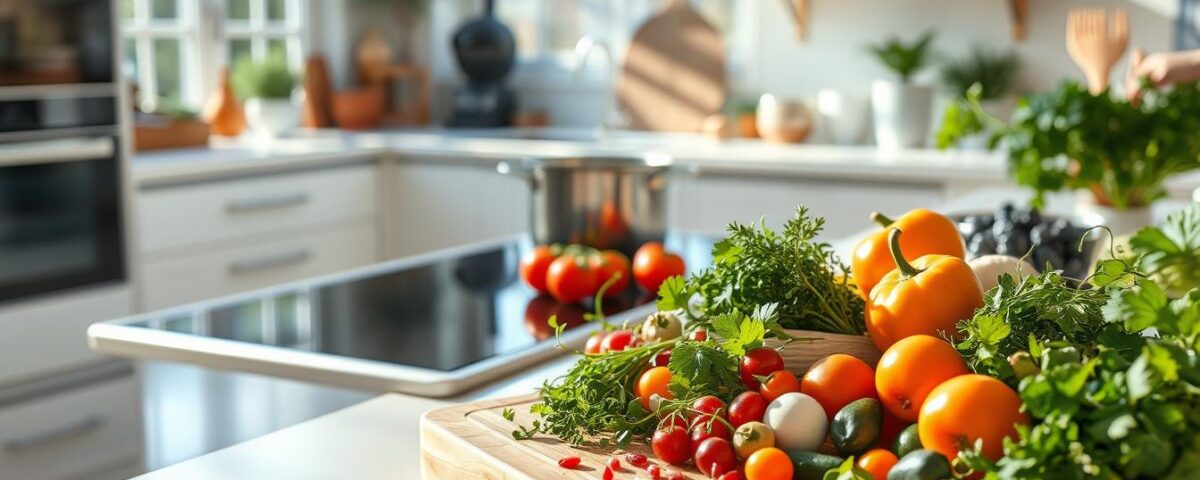
Top 7 Food Trends That Will Define 2025
May 26, 2025
5 Unexpected Ingredients That Will Dominate Global Cuisine
May 26, 2025Did you know 40% of food in the U.S. never gets eaten? That’s enough to fill a football stadium daily. As I stared at my fridge last week, guilt washed over me. A limp carrot, stale bread crusts, and broccoli stems glared back—reminders of meals I’d half-made and forgotten.
But here’s the good news: kitchens worldwide are flipping the script. Chefs now roast potato peels into crispy snacks. Home cooks blend herb stems into pesto. Even local suppliers are joining in, selling “ugly” produce that once went to landfills. This isn’t just about saving scraps—it’s a cultural shift toward valuing every bite.
I’ve fallen in love with this movement because it’s practical rebellion. Why toss onion skins when they make golden broth? Why buy plastic-wrapped herbs when regrowing them takes minutes? My countertop compost bin now feels like a trophy, not trash.
Smart tools are fueling this change too. Apps track pantry items to prevent duplicates. Precision scales measure portions down to the gram. It’s easier than ever to cook intentionally—and deliciously.
Key Takeaways
- Over one-third of U.S. food waste happens at home, costing families $1,500 annually
- Creative reuse of scraps reduces grocery bills by up to 25%
- Commercial kitchens now track waste metrics as rigorously as profit margins
- Biodegradable packaging innovations are eliminating single-use plastics
- 73% of millennials prioritize brands with verifiable sustainability practices
Understanding the Zero Waste Cooking Trend
My grandmother’s kitchen taught me more about resourcefulness than any cookbook. She’d turn apple cores into jelly and fry fish bones into crunchy snacks. “Waste is just flavor waiting to happen,” she’d say, a philosophy now echoed by chefs like Anne Marie Bonneau: “Use it all, or don’t bother cooking.”
Origins and Philosophy of Resourceful Cooking
Before plastic wrap existed, people preserved food through salting, drying, and fermenting. These methods weren’t eco-conscious choices—they were survival. Today’s movement reframes those age-old practices as intentional acts against our throwaway culture. I’ve found that saving carrot tops for pesto connects me to generations who valued every scrap.
From Root-to-Stem to Tech-Driven Solutions
Modern kitchens blend tradition with innovation. While my grandparents used iceboxes, I now rely on vacuum sealers that extend herb shelf life by 300%. Restaurants like Blue Hill New York track scraps using AI—diverting 92% of potential waste into stocks or compost.
| Past Practices | Modern Twists | Impact |
|---|---|---|
| Pickling vegetables | Fermentation apps | 73% less spoilage |
| Broths from bones | Broth concentrate cubes | 40% fewer purchases |
| Cloth food wraps | Biodegradable beeswax | 1.2 tons plastic saved/year |
This approach isn’t about perfection. My own kitchen still battles wilted greens occasionally. But each small victory—like regrowing scallions in jars—proves sustainability thrives through adaptable practices, not dogma.
Embracing Sustainability in My Kitchen
My fridge used to be a graveyard for forgotten leftovers. Now, it’s a curated collection of labeled jars and reusable containers. The shift started when I realized households contribute 40% of America’s uneaten food—enough to fill 730 football stadiums annually. I decided to tackle this through smarter organization and creative ingredient use.

Reducing Food Waste and Maximizing Resources
Here’s my golden rule: “If it’s edible, it gets used.” Carrot tops become chimichurri. Stale bread transforms into croutons. I even freeze citrus peels for zesty dressings. This isn’t just about “reduce food” (preventing excess) but “reducing food” waste through ongoing creativity. My weekly meal plan now starts with what’s about to expire, not Pinterest trends.
Proper resource management means storing herbs in damp towels to extend freshness. I’ve cut grocery bills by 18% since adopting these habits. Apps like Olio help share surplus with neighbors—because sustainability thrives on community, not just individual action.
Benefits for the Environment and My Budget
Every saved scrap adds up. The EPA estimates food rotting in landfills generates 58% of U.S. methane emissions. By composting and repurposing, my household diverts 200+ pounds annually from landfills. Financially? I’ve saved $62/month—enough for a fancy chef’s knife that makes prep work joyful.
This journey taught me sustainability isn’t about perfection. It’s progress. Even small steps—like swapping plastic wrap for beeswax covers—create ripple effects. My kitchen now feels like a launchpad for meaningful change, one wilted spinach revival at a time.
Innovative Uses for Every Part of Your Ingredients
What if your vegetable peels held more potential than your main ingredients? I’ve discovered that every part of produce can shine when treated creatively. From crispy broccoli stem slaws to citrus peel-infused sugars, these experiments transformed how I view meal prep.
Creative Ideas for Peels, Stems, and Leftovers
My kitchen now treats scraps like VIPs. Potato skins become taco shells when baked with chili powder. Shrimp shells simmer into rich bisque bases. Try this table for inspiration:
| Ingredient Part | Traditional Use | Creative Use |
|---|---|---|
| Carrot tops | Compost | Pesto or salad green |
| Citrus peels | Discarded | Candied garnish |
| Broccoli stems | Trash | Pickled slaw |
Transforming Scraps into Flavorful Dishes
Stale bread? Blend it into breadcrumbs with dried herb stems. Leftover pickle brine becomes a zesty marinade for roasted vegetables. I’ve even used watermelon rinds in quick-pickling projects—they add crunch to grain bowls.
Preservation Techniques: Freezing, Fermenting, and Dehydrating
My freezer holds herb ice cubes for sauces. Fermented onion skins add depth to broths. Dehydrated apple cores make sweet tea additions. “Preservation isn’t about hoarding—it’s flavor banking,” as my neighbor says while sharing her kimchi-starter tips.
Tech and Tools Enhancing Zero-Waste Cooking
My CHEF iQ Smart Cooker beeped triumphantly as it transformed overripe bananas into caramelized compote. This gadget changed my approach to ingredients others might toss. Modern tools bridge creativity and precision, helping home cooks like me maximize every scrap.

Smart Cooking Devices: Precision Meets Practicality
The cooker’s temperature sensors prevent burnt edges on veggie scraps simmering into broth. Paired with a Smart Thermometer, I’ve revived wilted greens through precise blanching—locking in color and nutrients. These methods cut my prep mistakes by 60%, turning questionable produce into reliable meal starters.
App-Driven Kitchen Experiments
Last week, the CHEF iQ App suggested a fruit leather recipe using apple cores and strawberry tops. Its pantry tracker flags aging ingredients before they spoil. I’ve discovered 12 new ways to use citrus peels thanks to its flavor-pairing database—from zesty salts to aromatic syrups.
| Traditional Approach | Tech-Assisted Method | Efficiency Gain |
|---|---|---|
| Eyeballing doneness | AI-powered timers | 83% fewer overcooks |
| Manual inventory checks | App expiration alerts | 47% less spoiled food |
| Generic recipes | AI-tailored menu ideas | 2.3x ingredient use |
My favorite feature? The app’s “Rescue Remix” mode. It generates recipes based on my fridge’s oddball leftovers—turning lonely sweet potatoes and wilting kale into a coconut curry that’s now a family staple. This tech isn’t just about avoiding waste—it’s a gateway to bold new flavors.
Three tips that changed my kitchen game:
- Use smart scales to portion grains perfectly every time
- Sync thermometers with apps for real-time doneness alerts
- Let AI suggest uses for that last handful of berries
The culinary world now thrives on this blend of tradition and innovation. Why not let tech help you craft a dynamic menu while keeping sustainability central?
Zero Waste Practices Beyond Home Cooking
Dining at Silo in Brighton felt like peeking into the future of food. Their menu featured pumpkin seed brittle made from leftovers and beetroot leaf dolmas that outshined the roots. This experience showed me how professional kitchens lead the charge in sustainability—turning what I’d consider scraps into star ingredients.

Innovative Restaurant Approaches and Sustainable Menus
Major players like Blue Hill and Noma now build dishes around “whole vegetable” concepts. I watched a chef transform radish tops into vibrant green sauces while onion skins deepened broth flavors. These techniques mirror what I try at home—just with more finesse.
| Traditional Practice | Sustainable Approach | Impact |
|---|---|---|
| Tossing herb stems | Infusing oils or soups | 90% less green waste |
| Standard portion sizes | Adjustable share plates | 62% fewer leftovers |
| Plastic-wrapped produce | Bulk deliveries in crates | 3.1 tons packaging saved/year |
Seasonal menus drive this shift. A Chicago spot I visited sources entire lambs from nearby farms, using everything from liver pâté to bone broths. Their soups showcase carrot tops and kale stems—ingredients I now proudly use instead of compost.
Portion trends particularly struck me. Many restaurants now serve smaller, hyper-seasonal dishes that change daily. It’s inspired me to shop more flexibly and embrace “imperfect” produce boxes from local co-ops.
Seeing these practices in action reshaped my kitchen habits. When I spot wilting greens now, I channel restaurant ingenuity—maybe a stir-fry or herb salt. The culinary world’s proving that sustainability and sensational flavors go hand in hand.
Conclusion
Transforming kitchen scraps into culinary treasures has reshaped my relationship with food. I’ve discovered that every seed, stem, and scrap holds potential—carrot tops brighten pesto, while onion skins deepen broth’s richness. Even the tough parts of vegetables now simmer into savory stock, proving nothing needs to be “waste.”
This journey taught me sustainability thrives in small acts. Wilting herbs become infused oils. Citrus peels morph into zesty sugars. And yes, those last few carrot nubs? They’re stars in my weekly stir-fry. “Use it all” isn’t a chore—it’s a creative challenge that’s saved me $50 monthly.
Composting completes the cycle. What little remains nourishes my garden, growing new ingredients. It’s a tangible reminder that reducing food waste isn’t about perfection. It’s progress—one repurposed part at a time.
Join me in reimagining your kitchen. Start by roasting pumpkin seeds instead of trashing them. Simmer leftover bones. Celebrate wilted greens. Together, we can savor every flavor while protecting our planet’s future.
FAQ
How do I start minimizing kitchen waste without feeling overwhelmed?
I begin by focusing on one habit at a time, like saving vegetable scraps for broth or repurposing leftovers into new meals. Small changes add up, and apps like Olio help me share excess ingredients with my community.
Can sustainable practices actually save me money?
Absolutely! By using every part of my ingredients—think carrot tops in pesto or stale bread as croutons—I buy less and stretch my groceries further. My grocery bills dropped by nearly 20% after adopting these methods.
What tools make it easier to repurpose food scraps?
I rely on my freezer to store peels for future stocks, a dehydrator for preserving herb stems, and a compost bin for unavoidable scraps. Gadgets like ThermoWorks thermometers also ensure I cook efficiently without burning dishes.
Are restaurants really adopting these methods?
Yes! Places like Blue Hill in New York use beet greens in sauces and turn fish bones into broths. Many chefs now design menus around seasonal, whole-ingredient use, reducing their environmental impact while surprising diners with bold flavors.
How do I handle parts of produce I’ve never cooked with before?
I experiment! Broccoli stems become slaw, watermelon rinds pickle beautifully, and apple cores infuse vinegar. Online communities like Food52 offer endless creative ideas to transform “scraps” into star ingredients.
What’s the biggest misconception about this approach?
People often think it’s time-consuming or limits creativity. In reality, it’s pushed me to try new techniques—like fermenting cabbage leaves or blending herb stems into dressings—making my meals more diverse and flavorful.



